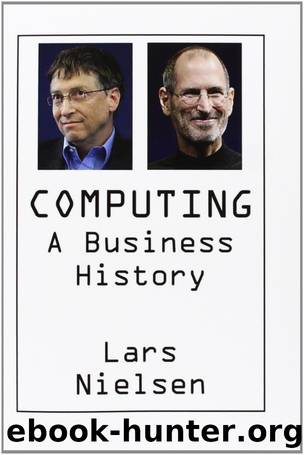Computing: A Business History by Lars Nielsen

Author:Lars Nielsen [Nielsen, Lars]
Language: eng
Format: epub
ISBN: 9780615675770
Amazon: 0615675778
Publisher: New Street Communications, LLC
Published: 2012-07-25T00:00:00+00:00
9
Bring on the Clones
"A computer lets you make more mistakes faster than any invention in human history - with the possible exceptions of handguns and tequila."
- Mitch Ratcliffe, programmer
From the start, the Macintosh was a "closed" architecture. Unlike the PC or the Apple II, there were no slots for users to add boards or otherwise customize the hardware. There were also to be no clones of this or any other Apple machine, because Apple controlled all rights to its operating system and held patents on the vast majority of Macintosh parts. Going forward, Apple was always to remain the sole purveyor of any of its hardware products, as well as its operating systems, thus dictating prices for the market.
Not so with regard to the IBM PC, for which IBM owned only the rudimentary BIOS input/output code. IBM had no exclusivity in its license for MS-DOS. As well, the PC was made up of parts from other manufacturers for which IBM held no exclusive rights. Thus competitors were free to reverse engineer their own versions of the PC to run MS-DOS so long as they devised their own BIOS code, which was not hard to do.
The first out of the gate was a machine from a new firm called Compaq (acronym for Compatability and Quality), formed in 1982 by three former Texas Instruments engineers: Rod Canion, Jim Harris and Bill Murto. The "Compaq Portable" emerged in 1983 - a machine capable of doing everything the PC could, running precisely the same software, but considerably smaller - so much so that it gained the slang name "suitcase computer." This was rapidly followed by Compaq's aggressively priced "DeskPro" line of desktop computers. Per Ceruzzi: "What made it a success was its complete compatibility with the IBM PC at a competitive price. Compaq's sales propelled the company into the top 100 rankings of computer companies by 1985, one of the fastest trajectories of any start-up." Compaq would go on to be acquired by another clone-maker, Hewlett-Packard, in 2002 - at a price of $25 billion.
At first, few clones other than Compaq's offered full compatibility. The ability to run Lotus 1-2-3 or Microsoft Flight Simulator became a standard stress test employed by reviewers and users. Soon, Phoenix Technologies developed an IBM-compatible BIOS available for license - enabling virtually anyone to build a 100% compatible clone without any R&D whatsoever. Thus other clones soon followed from such new firms as Michael Dell's PCs Limited - firms which were to log far more unit-sales than would IBM through the years.
After Compaq, Dell's firm turned into the most significant of all clone makers. As a student at the University of Texas, Austin, Michael Dell launched PCs Limited out of his dorm room in 1984. Later, after borrowing about $300,000 in start-up capital from his family, Dell dropped out of school in order to pursue his business full-time.
The company produced its first computer - the "Turbo PC", selling for $795 - in 1985. All of PCs Limited's sales were direct to consumers, the machines being marketed through ads in computer magazines.
Download
This site does not store any files on its server. We only index and link to content provided by other sites. Please contact the content providers to delete copyright contents if any and email us, we'll remove relevant links or contents immediately.
International Integration of the Brazilian Economy by Elias C. Grivoyannis(70267)
The Radium Girls by Kate Moore(11564)
Turbulence by E. J. Noyes(7660)
Nudge - Improving Decisions about Health, Wealth, and Happiness by Thaler Sunstein(7190)
The Black Swan by Nassim Nicholas Taleb(6719)
Rich Dad Poor Dad by Robert T. Kiyosaki(6109)
Pioneering Portfolio Management by David F. Swensen(6036)
Man-made Catastrophes and Risk Information Concealment by Dmitry Chernov & Didier Sornette(5593)
Zero to One by Peter Thiel(5444)
Secrecy World by Jake Bernstein(4342)
Millionaire: The Philanderer, Gambler, and Duelist Who Invented Modern Finance by Janet Gleeson(4047)
The Age of Surveillance Capitalism by Shoshana Zuboff(3950)
Skin in the Game by Nassim Nicholas Taleb(3941)
The Money Culture by Michael Lewis(3791)
Bullshit Jobs by David Graeber(3788)
Skin in the Game: Hidden Asymmetries in Daily Life by Nassim Nicholas Taleb(3695)
The Dhandho Investor by Mohnish Pabrai(3533)
The Wisdom of Finance by Mihir Desai(3494)
Blockchain Basics by Daniel Drescher(3294)
